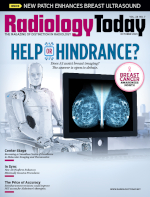 Editor’s Note: Attention to Detail
Editor’s Note: Attention to Detail
By David Yeager
Radiology Today
Vol. 24 No. 7 P. 4
October is Breast Cancer Awareness Month. According to the American Cancer Society , breast cancer is the second most common cancer in women in the United States, behind skin cancer, and it accounts for nearly one-third of all new cancers in women each year. The National Cancer Institute (NCI) estimates that approximately 297,700 new cases of breast cancer will be diagnosed in 2023, accounting for 15.2% of new cancer cases in women. Although the five-year relative survival rate of breast cancer has been trending upward since 1975 and was 90.8% from 2013 to 2018, the NCI estimates that approximately 43,170 women will die from breast cancer in 2023, representing 7.1% of all cancer deaths among women.
Breast cancer screening has long been a cornerstone of breast cancer prevention. In 2021, 75.9% of women in the United States aged 50 to 74 had received a mammogram within the previous two years, according to the NCI . In recent years, the use of digital breast tomosynthesis (DBT), sometimes called 3D mammography, has increased. DBT provides more detail than standard mammography, but it also produces significantly more images. Radiologists, who have seen increases in image volumes from many imaging modalities, are working harder than ever to keep up.
Some studies have found that AI may be a useful tool for helping radiologists manage the flow of mammography and DBT images, but others have cast doubt on that premise. In this month’s cover feature, Beth W. Orenstein examines both sides of the debate. Although AI has been seen as an aid to workflow in some contexts, it is also prone to bias, suggesting that more research is required before it can be used reliably.
Also in this issue, Keith Loria profiles St. Joseph’s Health Care London and the Lawson Health Research Institute in Ontario, Canada. The organizations have partnered to form Canada’s first-ever Centre of Excellence for molecular imaging and theranostics. Loria reports that it has taken many years and a great deal of investment to bring this project to its current state.
Rebecca Montz has another story of technological innovation, this one dealing with augmented reality (AR). In July, the FDA approved the first AR platform that uses live imaging—in this case, ultrasound—overlaid on X-ray images for minimally invasive procedures, such as biopsies and tumor ablations. The platform creates a holographic anatomic display and tracks surgical instruments. Although it is in its early stages, several users believe it will have a broad range of applications.
Finally, Claudia Stahl looks at the state of Alzheimer’s disease imaging. New therapies may offer some benefit, and medical imaging will be crucial in determining their efficacy, but reimbursement rates for Alzheimer’s imaging are lagging. Medical imaging organizations have worked hard to change this situation, and their efforts may soon begin to pay off. The bipartisan Facilitating Innovative Nuclear Diagnostics Act of 2023 is working its way through Congress and, if it passes, will potentially expand access to PET imaging for Alzheimer’s disease, cancer, and neurological diseases. For more details, turn to page 22.
Enjoy the issue.
— Dave Yeager
david.yeager@gvpub.com
